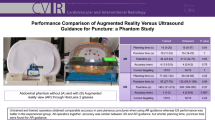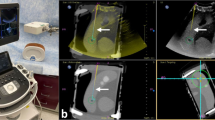Abstract
Image-guided surgery is growing in importance with each year. Various imaging technologies are used. The objective of this study was to test whether a new mixed reality navigation system (MRNS) improved percutaneous punctures. This system allowed to clearly visualize the needle tip, needle orientation, US probe and puncture target simultaneously with an interactive 3D computer user inferface. Prospective pre-clinical comparative study. An opaque ballistic gel phantom containing grapes of different sizes was used to simulate puncture targets. The evaluation consisted of ultrasound-guided (US-guided) needle punctures divided into two groups, standard group consisted of punctures using the standard approach (US-guided), and assisted navigation group consisted of punctures using MRNS. Once a puncture was completed, a computed tomography scan was made of the phantom and needle. The distance between the needle tip and the center of the target was measured. The time required to complete the puncture and puncture attempts was also calculated. Total participants was n = 23, between surgeons, medical technicians and radiologist. The participants were divided into novices (without experience, 69.6%) and experienced (with experience > 25 procedures, 30.4%). Each participant performed the puncture of six targets. For puncture completion time, the assisted navigation group was faster (42.1%) compared to the standard group (57.9%) (28.3 s ± 24.7 vs. 39.3 s ± 46.3—p 0.775). The total punctures attempts was lower in the assisted navigation group (35.4%) compared to the standard group (64.6%) (1.0 mm ± 0.2 vs. 1.8 mm ± 1.1—p 0.000). The assisted navigation group was more accurate than the standard group (4.2 ± 2.9 vs. 6.5 ± 4.7—p 0.003), observed in both novices and experienced groups. The use of MRNS improved ultrasound-guided percutaneous punctures parameters compared to the standard approach.




Similar content being viewed by others

References
Stefanidis D, Fanelli RD, Price R et al (2014) SAGES Guidelines Committee. SAGES guidelines for the introduction of new technology and techniques. Surg Endosc 28:2257–2271
Burgmans MC, den Harder JM, Meershoek P et al (2017) Phantom study investigating the accuracy of manual and automatic image fusion with the GE Logiq E9: implications for use in percutaneous liver interventions. Cardiovasc Intervent Radiol 40:914–923
Minami Y, Minami T, Chishina H et al (2016) US-US fusion imaging in radiofrequency ablation for liver metastases. Dig Dis 34:687–691
Sánchez Y, Anvari A, Samir AE et al (2017) Navigational guidance and ablation planning tools for interventional radiology. Curr Probl Diagn Radiol 46:225–233
Diana M, Soler L, Agnus V et al (2017) Prospective evaluation of precision multimodal gallbladder surgery navigation: virtual reality, near-infrared fluorescence, and X-ray-based intraoperative cholangiography. Ann Surg 266:890–897
Bruners P, Penzkofer T, Nagel M et al (2009) Electromagnetic tracking for CT-guided spine interventions: phantom, ex-vivo and in-vivo results. Eur Radiol 19:990–994
Rapagopal M, Venkatesan AM (2016) Image fusion and navigation platforms for percutaneous image-guided interventions. Abdom Radiol (NY) 41:620–628
Abi-Jaoudeh N, Kobeiter H, Xu S et al (2013) Image fusion during vascular and nonvascular image-guided procedures. Tech Vasc Interv Radiol 16:168–176
Hostettler A, Forest C, Forgione A et al (2005) Real-time ultrasonography simulator based on 3D CT-scan images. Stud Health Technol Inform 111:191–193
Lee MW, Park HJ, Kang TW et al (2017) Image fusion of real-time ultrasonography with computed tomography: factors affecting the registration error and motion of focal hepatic lesions. Ultrasound Med Biol 43:2024–2032
Ewertsen C, Henriksen BM, Torp-Pedersen S et al (2011) Characterization by biopsy or CEUS of liver lesions guided by image fusion between ultrasonography and CT, PET/CT or MRI. Ultraschall Med 32:191–197
Barbero U, Budano C, Golzio PG et al (2018) Combining electromagnetic navigation and 3-D map** to reduce fluoroscopy time and achieve optimal CRT response. Pacing Clin Electrophysiol 41:557–560
Rouchy RC, Moreau-Gaudry A, Chipon E et al (2017) Evaluation of the clinical benefit of an electromagnetic navigation system for CT-guided interventional radiology procedures in the thoraco-abdominal region compared with conventional CT guidance (CTNAV II): study protocol for a randomised controlled trial. Trials 18:306
Wood BJ, Zhang H, Durrani A et al (2005) Navigation with electromagnetic tracking for interventional radiology procedures: a feasibility study. J Vasc Interv Radiol 16:493–505
Diana M, Halvax P, Mertz D et al (2015) Improving echo-guided procedures using an ultrasound-CT image fusion system. Surg Innov 22:217–222
Acknowledgements
The authors wish to thank Toby Collins for his help in proofreading the article.
Author information
Authors and Affiliations
Corresponding author
Ethics declarations
Disclosure
Carlos F. Davrieux, Mariano E. Giménez, Cristians A. González, Alexandre Ancel, Maxime Guinin, Bénédicte Fahrer, Edgardo Serra, Jung-Myun Kwak, Jacques Marescaux, and Alexandre Hostettler have no conflicts of interest or financial ties to disclose.
Additional information
Publisher’s Note
Springer Nature remains neutral with regard to jurisdictional claims in published maps and institutional affiliations.
Rights and permissions
About this article
Cite this article
Davrieux, C.F., Giménez, M.E., González, C.A. et al. Mixed reality navigation system for ultrasound-guided percutaneous punctures: a pre-clinical evaluation. Surg Endosc 34, 226–230 (2020). https://doi.org/10.1007/s00464-019-06755-5
Received:
Accepted:
Published:
Issue Date:
DOI: https://doi.org/10.1007/s00464-019-06755-5



